#indonesian diaspora
Text
So proud of my collaborator & business partner Thom for this very important essay via Reactor on the Marvel Cinematic Universe's Madripoor, a fictional city they've now set in Indonesia. Please read, please share & learn some history from a member of the Indonesian diaspora who beautifully weaves in his own family's difficult life experiences into this article about how Southeast Asia is depicted.
Please share, because I didn't know the Indonesian history Thom shares here and I find that tragic. Learn something new today!
#marvel#marvel mcu#mcu#comics#indonesia#indonesian#history#diaspora#southeast asia#southeast asian history#archipelago#personal essay#essay#essay writing#discussion#academics#narrative#orientalism#media critique#commentary#diversity#wwii history#wolverine: madripoor knights#madripoor#orientalist#internment camp
4 notes
·
View notes
Text
As chinese indonesian, reading the dear readers part of dial a for aunties literally made me fucking tear up 🥲
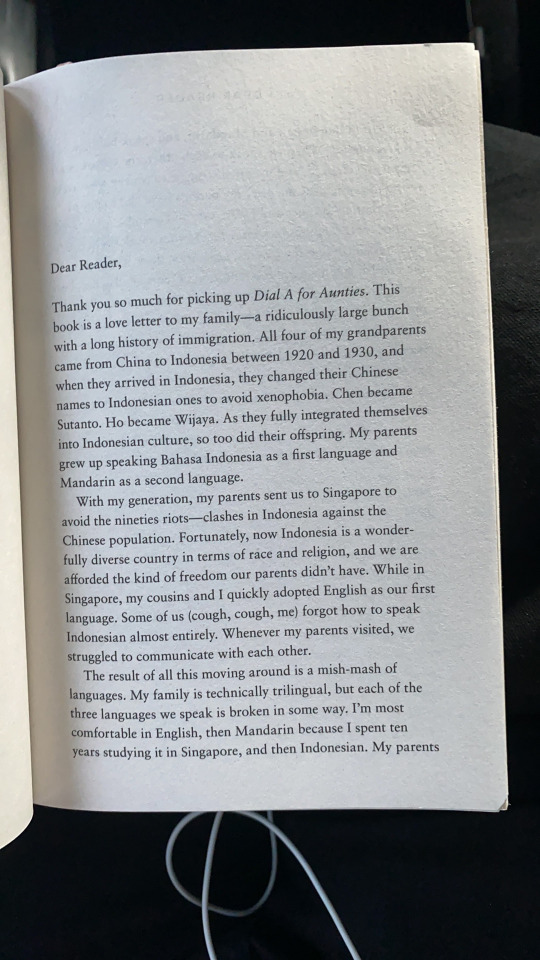
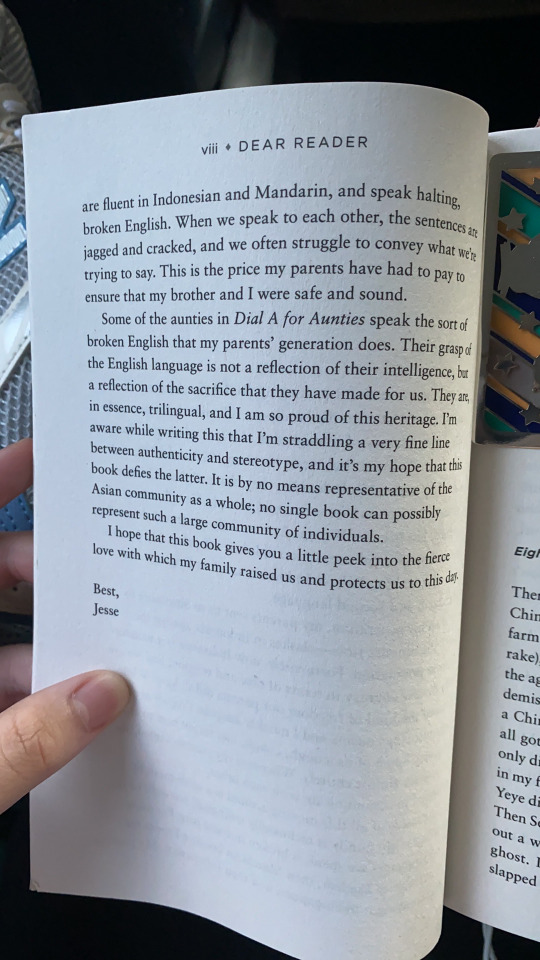
Like what the fuck, why is this kinda relatable even though I wasn’t even born in the 90s *sobbing 🙃
#jesse q sutanto#dial a for aunties#dafd#books#Chinese Indonesia#indonesian#chinese#asian diaspora#immigration#sobbing#random thoughts#finally starting a book
7 notes
·
View notes
Text
Hhhh- more research right now.
I’m a massive foodie and want to try so much cuisine out there (even stuff like durian fruit). So it’s fun researching foods from different cultures. Did some Filipino dishes for the Begotten!Twins...
Now thinking about what kind of Indonesian lunch food I can see Virgil packing with him to this Awkward Peace Talk With Roman (orchestrated by Patton).
Not sure about what’s in the “lunch“ category, just yet (lotsa cultures don’t traditionally categorize meals by lunch/etc. - see Korean food). But my mouth watered over balado terong. I friggin’ love eggplant dishes so gd much, and absurd Scoville scalability? Yes. I want my mouth to be on fire, rn.
(Though I think the downside for him eating that one much around the crew - is just being mindful of Janus’s shellfish allergy. But at this point, he hasn’t met them.)
Maybe with a side of tahu gejrot... or some gorengan. (Look. Deep-fried damn near anything is good shit.)
Indomie (which can be as easy to make as instant ramen) sounds like a potential low-energy meal he could scrounge up for himself, too. :Ic
(Aaand now I want iZ!Logan to be seen eating Korean food at some point. Hhhh- I want kimchi so bad now, too.)
#sanders sides#virgil sanders#roman sanders#patton sanders#janus sanders#remus sanders#logan sanders#food/#(been trying to put in asian rep in every one of my AUs)#(i'm half-korean sooo...)#(the only reason kid me liked going to church w/ mom was all the gd delicious af korean food jfc)#(food is probably the only tangible connection to my mom's culture and family i have - so I Have Feelings)#(but yeah - virgil's indonesian diaspora in gymrat!au)#(also just love seafood and how there's so much of that in these cultures... for obv geographical reasons)
7 notes
·
View notes
Note
CAN YOU EXPLAIN TO ME INDOCHU
i deadass havent heard of it before but it seems neat and ya seem like the expert on it so i was wondering like what is their vibes and stuffs
SDHGHSGHSAJ I HAVE NEVER POSTED IT BUT OKAY I CAN TRY TO EXPLAIN? (thanks to my indonesian friend for helping out again weee)
Sukarno, the leader of the Indonesian independence movement and the first president of an independent Indonesia, cultivated a close relationship with Mao's China as part of an anti-imperialism alliance and the wider NAM movement, as well as his own "Guided Democracy" philosophy. However, after Suharto ousted Sukarno from power, he cut ties with the PRC and banned Chinese literature, culture, and characters; he went so far to ban Chinese Indonesians, particularly those on Java, from using their Chinese names.
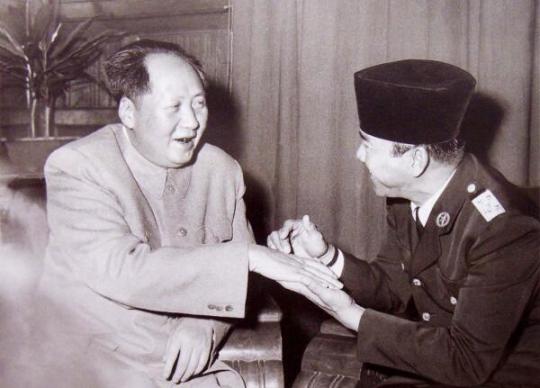
Mao even went so far to fund Sukarno's attempt at creating an alternative to the Olympics, GANEFO (Games of New Emerging Forces), even though it was only ever hosted twice lol
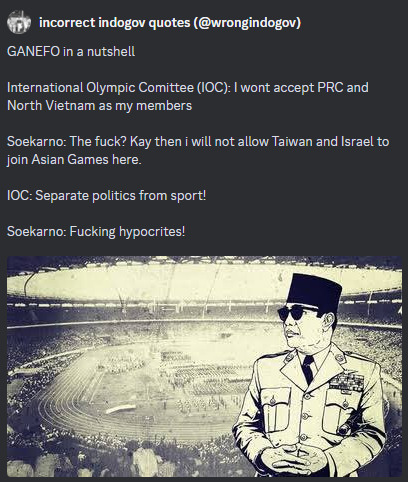
There's a significant Chinese diaspora population in Indonesia and despite facing cultural suppression from the Suharto era government and anti-Chinese sentiment from Native Indonesians, have markedly impacted Indonesian culture and history as a whole.
The current Indonesian president is Pro-China and maintains close ties between Indonesia and the PRC.
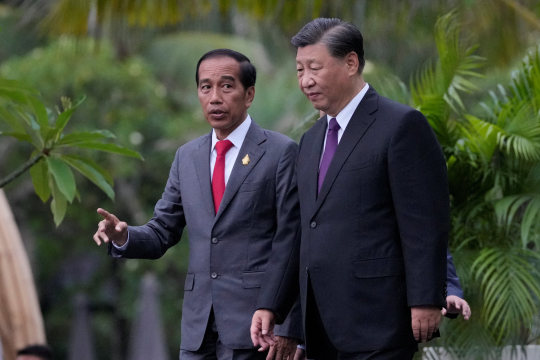
So (according to people way more enthusiastic about Indochu than I am) Indochu is appealing because of how grey both of these countries are as well as their relationships- they have a long, mixed (and sometimes very sensitive) history with each other with a lot of potential. Realistically, today they probably wouldn't consider each other notably close partners, as it's more because they just happen to have certain interests line up, such as standing against western economic domination and security guarantees. But hey, I see the chemistry 🤔
This is of course, assuming you actually meant to ask about indonesia x China and not India x China, which in that case gosh... SORRY FOR WASTING EVERYONE'S TIME....
(But I'm currently writing a oneshot collection which heavily features India x China and shows off a lot of what I enjoy most about their dynamic, so give it a read! I also have multiple India x China fics up there so those are an option as well)
#hetalia#ask#anonymous#hws china#hws indonesia#indochu#historical hetalia#sorry if i get smth wrong this is only a brief overview
25 notes
·
View notes
Note
Ned being the only one who understand flavours is so weird
TBH not rly. My headcanon is that he of course still cannot consume spice the way Indonesians are BUT he does indulge in Indonesian food here and there, because Indonesian food is pretty big in Netherlands to my knowledge… tho I think he prefers the mainly-sweet dishes like satay because satay sauce (yknow sate ayam) is big there for a reason I don’t rly get. And there goes another headcanon that Ned actually likes sweets more than Masindo does LOL.
He understands more about selling spice ofc. I’ve been hearing stories of ppl (Indo diaspora) going to Netherlands from neighboring countries to get spice…
8 notes
·
View notes
Photo





Some of the 150 members of Melbourne’s Indonesian Diaspora who performed in the 69th Annual Moomba Parade. 11 March 2023
https://www.flickr.com/photos/malachytarpeyphotography/
10 notes
·
View notes
Note
music of SEA class? how was it? 👀
hehe it was pretty interesting. we have a specific set of lectures on the philippines, though it looks like in those we'll be focusing on the effects of diaspora on music and how filipino performers are perceived abroad (OFWs, etc)
seems like a fun course to explore differing musical traditions across sea, though it seems to be more of a Crash Course On Southeast Asian History And Geopolitics Through The Lens Of Music, which i'm fine with but sometimes it's like. sigh i think i've seen this film before etc. like we had a whole bit talking about colonization and there was a whole slide with a list of each country's colonizers like leporello's list of women and i know most americans are just ignorant about it but it's just. it's one thing when you're learning it in a purely academic, objective sense but when you know and have seen the ramifications on a personal level, it's just. yeah. a little disquieting.
anyways this doesn't really answer any question and i don't want to just be complaining about it, so what i'll say is that i enjoy that the professor's greatest strength so far is how she constantly reminds the students that they can't project their own notions of expression onto others (had a lot of students say that indonesian performers were 'unhappy to be there' bc they weren't smiling) which i hope extends to other things as well.
#it feels strange to see something that i've witnessed parts of first hand#be treated in the academic sense in a faraway place. i hope that makes sense#em answers#iskul bukol: undergrad edition
6 notes
·
View notes
Text
I don't know if this should go into my upcoming introduction post instead. But it might make it too long, so it might be better if I made a separate post for this.
Not all Hong Kongers are ethnically Chinese! Sure, Han Chinese people are the supermajority population, but we are also a multicultural society, with South Asian (Indians, Pakistanis, Nepalese), SEAsian (Indonesians, Filipinos, Thais, Vietnamese) communities, as well as smaller communities of Japanese, Koreans, and diaspora groups from the Anglosphere.
Some people might just live here, but there are also some non-Chinese people that identify as Hong Kongers.
Just so you know to keep this in mind, and don't just say someone is Chinese as soon as they tell you they're from HK
4 notes
·
View notes
Text
The life we choose
I had a good friend who, a few weeks after I got back to Indonesia, told me that she was going to marry a foreigner and she will be moving to France. It was such a drastic and sudden decision that I could not help to start thinking about our numbered days. We were first acquainted back in senior high school and to be honest we were not that close. About how she (and hopefully, I to her) ended up becoming one of my longest lasting friends, I could not really remember how. We did not go into the same university or shared the same academic interests.
I remembered asking, “Are you sure?” because to me, it was a life of too many uncertainties. Going abroad to start a new life in a foreign land without a single person who’s blood related, straight into a committed relationship that is supposed to last a lifetime. One of the first things that I brought up to her was to not give up her Indonesian passport as long as her immediate family members are still around (because, for all we know, some people are unbelievably eager to lay their hands on any passport that has no garuda stamped on its cover). I remembered thinking that she was so brave. But wasn’t she being unreasonably brave?
The next thing I told her was to save the number of the local embassy and to quickly set up a new support system. And that if anything (god forbid) goes south, she should just come straight home.
I told her about the story of this one Indonesian diaspora woman who apparently had given up her Indonesian citizenship, and she went through so much trouble just to go back to Indonesia at the peak of Covid back in late 2020. Her ailing mother was dying, and everybody in the family was already coming to the hospital. All but her. Because of the travel restrictions, the Indonesian embassy could not issue any visa. No foreign citizens were allowed in. Only those with a permanent residence/Indonesian citizenship could still travel to Indonesia. Her red passport excludes her from this very short list.
For weeks, she shared all her struggles of trying to get to Indonesia before her mother’s passing. All from trying to find insiders, to the ridiculously priced visa fee of 3,000 euros, to being turned away by the Indonesian embassy because it was just not possible. I remembered reading her updates on IG stories to kill time - all the while thinking that my Indonesian passport might be weak, but it is priceless because it will be the only thing permitting me to get home even in the middle of a tiny doomsday. The story ended quite well for the woman - thankfully, she was able to pull some strings and got into Indonesia just a few days before her mother pass away.
(Sorry but at the time I could not help but to think what is so difficult about going every several years to renew your residence permit and keep a piece of legal document that links you to homeland)
It’s crazy to think how the decision we made a few years back could make our life so difficult at the most unthinkable times. It is ultimately your life, and my life, to each of our own, so of course everyone is entitled to their decisions. But remember to think so, so far into the future, weigh every pros and cons, and always, always to think of the worst case scenario.
Because this is a life that we choose.
14 notes
·
View notes
Text

What is this? I am reading again? You bet I am!
I sort-of read Someone Wicked by @artsyunderstudy and it is so worth the hype. “Sort-of” read because I *gestures around* *cha chas real smooth* am still figuring out my relationship with smut, which is why I didn’t read it earlier, but I did and I picked the worst time to start, huh? @letraspal made a meme for it here and that was my exact reaction. I was crying in my bed at 11am with the final chapter open on my phone aka I cannot wait till the 27th.
@annepi-blog wrote their first fic Let me be the one. Welcome, welcome to the Klaine fic world! I love that Kurt “reclaims” the skirt!
Lastly, I am finally catching up with For this Day, For this Moment by Lottiethroughthelookingglass, the Torchwood fic that I have been following, but I lost track of it because of thesis stuff. It was completed a while ago, but I just didn’t have time and now I do and I am in a puddle. I don’t know how many of my followers are into Torchwood. Heck, I myself have never watched Torchwood (for reasons), but this fic is sooooo good and I recommend it.
For non-fic reading, I’m currently reading a book on the history of Chinese-Indonesian restaurants in the Netherlands, because I am of the belief that diaspora food should be respected as its own cuisine, instead of being written off as “fake” or “not-authentic”. If you’re interested in this topic, I highly recommend the video’s by Xiran Jay Zhao and Demystified Chinese Cooking (after the 12:00 mark). Thanks for coming to my mini Ted Talk.
6 notes
·
View notes
Text
Neo Twiny Jam - bite-sized review
The Neo Twiny Jam (@neo-twiny-jam) is an interactive fiction game unranked jam where participants could not write more than 500 words per entry.
You can find every submitted piece on the jam's Itch Page.
=============
June 1998, Sydney by Kastel
Entry - More by Kastel
The Merging of Different Worlds....
In May of 1998, riots erupted in Jakarta, resulting in of the diaspora of Chinese Indonesians towards, among others, Australia. This is an important context to understand the situation of the main character and her family.
As the broken family settles in their new home, a strange dynamic forms, leaving the main character in a sort of emotional limbo state, avoiding acts that could tip the balance of this fragile situation the wrong way.
It is heartbreaking.
2 notes
·
View notes
Text
For the hell of it... here’s some (AU) ethnic/cultural background HCs (all diaspora), in one place... (some I’m still crystallizing here.)
Roman & Remus
iZombie (Ortiz) - Italian / Spanish
Gymrat (Sanchez) - Mexican
Begotten (Espinoza) - Costa Rican / Filipino
Virgil
iZombie (Enache) - Romanian
Gymrat (Baskoro) - Indonesian
Begotten (Delacroix) - Cajun / x
Janus
iZombie (Scorsone) - Italian
Gymrat (Drivas) - Greek
Begotten (Miele) - Italian / x
Patton
iZombie (Baker) - English
Gymrat (Wattson) - Scottish
Begotten (Metz) - German / x
Logan
iZombie (Min) - Korean / White
Gymrat (Houlmes) - African American
Begotten (Sumner; AKA Ellis Croft) - English / x
#sanders sides#roman sanders#remus sanders#virgil sanders#janus sanders#patton sanders#logan sanders#(iZ!logan is/was me doing some wish fulfillment... being white/korean and wanting to have his job as a medical examiner)
8 notes
·
View notes
Text

Sketch of contemporary poet Li-Young Lee (Krita, 2023), an American poet of Chinese-Indonesian descent.
Drawn during a recent episode of identity-related anxiety, after I read the following work by him:
People have been trying to kill me since I was born,
a man tells his son, trying to explain
the wisdom of learning a second tongue.
It's the same old story from the previous century
about my father and me.
The same old story from yesterday morning
about me and my son.
It's called "Survival Strategies
and the Melancholy of Racial Assimilation."
It's called "Psychological Paradigms of Displaced Persons,"
called "The Child Who'd Rather Play than Study."
Practice until you feel
the language inside you, says the man.
But what does he know about inside and outside,
my father who was spared nothing
in spite of the languages he used?
And me, confused about the flesh and soul,
who asked once into a telephone,
Am I inside you?
You're always inside me, a woman answered,
at peace with the body's finitude,
at peace with the soul's disregard
of space and time.
Am I inside you? I asked once
lying between her legs, confused
about the body and the heart.
If you don't believe you're inside me, you're not,
she answered, at peace with the body's greed,
at peace with the heart's bewilderment.
It's an ancient story from yesterday evening
called "Patterns of Love in Peoples of Diaspora,"
called "Loss of the Homeplace
and the Defilement of the Beloved,"
called "I Want to Sing but I Don’t Know Any Songs."
"Immigrant Blues" from Behind My Eyes by Li-Young Lee. Copyright © 2008 by Li-Young Lee.
#digital art#krita illustration#digital drawing#drawn with krita#li young lee#poetry#indonesian american#asian american#aapiheritagemonth#caricature#portrait drawing#immigrant blues#poems and quotes
3 notes
·
View notes
Photo
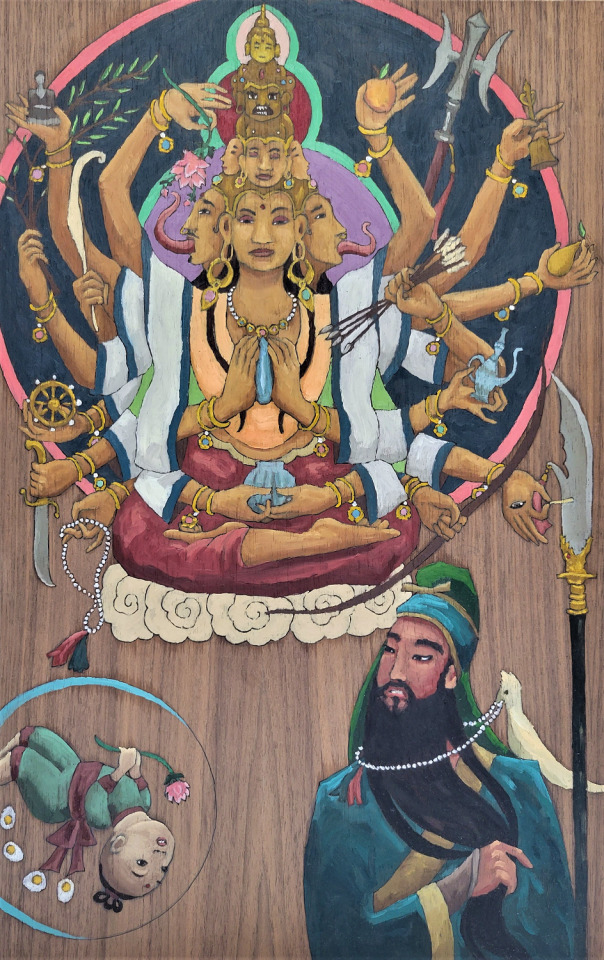
Guanyin and Guan Yu (with Shancai Tongzi too) 觀音 + 關羽 (还有善財童子) - Guanyin, the Buddhist deity of mercy and compassion is known as Avalokiteśvara in India, also revered by Burmese, Chinese, Tibetan, Vietnamese, Thai, Korean, Mongolian, Japanese, Indonesian, Khmer, and Hmong people, with several different names in every dialect of these diasporas. Guan Yu the guardian deity was a mortal man and military hero from China's Three Kingdoms period, his red face, long beard, and signature spear are commonly referenced in contemporary films, television, and video games
https://www.inprnt.com/gallery/eirikswood/guanyin-and-guan-yu/
7 notes
·
View notes
Text
Blog Post #2: A Piece of Indonesia in South Philly
I had a quick visit to South Philly with a friend last Wednesday to get Indonesian food from a restaurant called Hardena. Since my country Malaysia shares many cultural similarities with Indonesia, I was excited to know that there’s a highly integrated Indonesian diaspora community in the neighborhood. While waiting for our food, we talked to a lovely Indonesian couple dining next to our table. They recommended a few other Indonesian stores and cafes in the area. I was surprised to know from them that about 5,000 Indonesians live in South Philly. There is even a particular neighborhood which residents call “Kampung”, which means village in the Indonesian language.
Our conversation with the couple reminded me a lot of the discussions in class about "ethnic villagers". As Palen described in The Urban World, "ethnic villagers" exhibit a high degree of social interaction between each other and the neighborhoods which they reside in often reflects the family and peer orientation of a homogeneous small town than the attitudes of an impersonal large city. I observed a very tight relationship between residents of this area while I was in the restaurant. Most of the customers at the time of my visit seem to know each other and the owner of the restaurant. However, it was also interesting to see how the restaurant attracts not just the Indonesian diaspora, but even local Philadelphians.
We later decided to walk around the neighborhood near Hardena and visit some of the other Indonesian stores recommended by the friendly couple we met. One of the stores that we went into was Pendawa which is a store that sells food, snacks, spices, and groceries from Indonesia. Most of the Indonesian businesses are just a walking distance from each other, giving me the impression that there is indeed demand for Indonesian-related food and items in that area.
When I got home that day, I looked up on the Internet to learn more about the Indonesian community in South Philly. I learned about Modero & Company, a traditional and modern dance community promoting Indonesian culture through dance. Having discussed the idea of social capital in Putnam’s Bowling Alone book in class, Modero struck me as an example of how people can come together and build social capital through culture. I find it so interesting how this community of dancers thrive in a city with deteriorating social capital.
While the presence of this Indonesian neighborhood in South Philly is not as obvious as an area like Chinatown or Little Italy, it clearly binds the Indonesian community together with the existence of businesses selling Indonesian-related goods and community groups. However, I still wonder how the interactions between these “ethnic villagers” are changing over the recent years and whether they experience declining social capital too. I look forward to returning to South Philly and learning more about the people there and its culture!


3 notes
·
View notes
Text
Ea: Our Second Chance (4)
4. Earth, 2070
(> Back to 3. South of the Dagon Sea
> On to 5. Ea’s biosophere, two centuries later)

(full-sized image)
The world the 10,000 representatives of humankind left when they came to Ea. [Note for context: this map was drawn before the COVID pandemic, the US withdrawal from Afghanistan, and the invasion of Ukraine, and therefore takes none of those into account.]
THE 2020s: THE NILE WAR AND ITS AFTERMATH
In the "Culture War" flares of the 2010s and early 2020s, the extreme political blocs branch off on their own; by the end of the decade all that's left of the major parties are the bland centrist bureaucrats, as well as a multitude of unelectable hyperspecialized parties. American economy and politics is increasingly isolationist: many overseas military bases are dismantled; the UN establishes a secondary headquarter in Geneva, which soon becomes more important than the one in New York.
Ethiopia begins building an extensive dam system on the upper Nile. Negotiations with the downstream countries break down; eventually, the dams are bombed by the Egyptian air force. War spreads to all northeastern Africa, with significant interventions of Nigeria (on the Ethiopian side) and Saudi Arabia (on the Egyptian side). The whole region is devastated by the Nile War; in particular, Ethiopia collapses, and riots in Saudi Arabia threaten the monarchy.
In the aftermath of the Nile War, military government are propped up by the African Union to keep order in the devastated countries. The peacekeeping forces are largely provided by the countries of the East African Community. A mysterious man known as Muntu tours the archaeological sites of Africa preaching a religion founded on the common origin and nature of humankind. He is claimed to perform miraculous healing and to supernaturally escape death, converting his attackers to the new faith.
Poland and Ukraine form an alliance ("Intermarium") against the aggressive policies of Russia in the east. The alliance is soon extended to many other countries of eastern Europe.
Sea level rise and saltwater infiltration start making the soil of Bangladesh impossible to farm, and many regions will soon sink. Tens of millions of Bengali people scatter in the world. Europe, North America, and East Asia are hit by a refugee crisis far worse than a decade before. Agriculture also suffers worldwide; billions are spent to protect cities such as Miami, Rotterdam, and Venice from flooding. Sumatra, South Vietnam, and Louisiana suffer greatly.
By the end of the decade, permanent ice has all but disappeared in the Arctic, and the Indonesian rainforest is mostly gone. Space programs keep growing quietly, with manned missions by India, Brazil, South Africa, and South Korea. Genetic therapies are available for several diseases, including AIDS.
THE 2030s: BREAKING STRAIN
Warming in the Russian Far East exposes large traits of mining and farming ground. Since the Russian population is declining, the government provide incentives for foreigners to work that land. Millions of Chinese workers, fleeing the desertification of northeastern China, establish themselves there.
After many years of increasing economical and cultural integration, the countries of Kenya, Tanzania, Uganda, Rwanda, and Burundi join to form the East African Federation. Much wealth is brought in by the construction of an international space launch site on the Equator. The religion founded by Muntu, Umoja, is growing in popularity, though the Prophet is eventually killed in a terror attack in Geneva in 2034, along with 77 others.
The demographic shifts compounded by the Bengali Diaspora put strain on European politics. The United Kingdom withdraws from the continent altogether, threatening nuclear retaliation against any "breach of sovereignty". It offers to extend such protection to Ireland in exchange for its farming land. Japan and Australia do the same, although the latter is much less successful.
As oil becomes increasingly expensive to extract, and its use is phased out of most technology, many oil-exporting nations collapse. Saudi Arabia crumbles into anarchy, and will be put under "temporary" UN administration. Nigeria falls apart. A socialist revolution sweeps Iran destroying the islamic government. Dubai survives, reinventing itself as a new center of electronics and computer engineering.
In these years, the idea of the Exodus starts to spread. The first manned mission to Mars occurs, as well as many unmanned ones to the Outer Solar System, though there is little practical followup. A Suzhou corporation called Penglai is the greatest private backer of the missions (and many other growing technologies, including cryonics and geoengineering). A military coup in North Korea effectively places the country under Chinese control.
THE 2040s: GLOBAL REARRANGEMENTS
The European Union gives way. The "core" territories restructure themselves as the much tighter European Federation, while the southern countries create the Mediterranean Forum with Turkey and North Africa. Italy and Spain find themselves torn - quite literally - between the two. Umoja becomes popular in the Forum, while Catholic traditionalism sees a certain increase in popularity in the Federation.
Fed by Indian and Chinese investments, certain African countries undergo extreme economic grow and industrialization, developing into key financial and technological centers. Senegambia, Eswatini, Igboland, and Somaliland become the "African Lions". Dubai is sometimes counted as one due to its close economic and diplomatic ties.
Many island nations of the Pacific, such as Palau and Kiribati, start disappearing under the waves. After much political browbeating and bribing, the UN establishes a Pacific People Resettlement Area in the Australian inland, in a region already crowded by Bengali refugees. Umoja grows here as well. Inspired by the tragedy, a great movement for the protection of native peoples threatened by climate change sweeps the world, with particular appeal in Canada, Siberia, Sahel, and the Amazon.
The military junta ruling Pakistan after the recent coup attacks the troubled Iranian regime in the attempt to unite an increasingly fractured country. The war is brief, but it sees several biological and tactical nuclear attacks, eventually ending in the breakdown of Pakistan. International action pushes for a tighter control of WMD by the UN to prevent future horrors as those of the Iran-Pakistani War.
As traditional Protestantism fades away from US culture, Mormonism grows in popularity as the "true" American religion. Worsening droughts in the Southwest and hurricanes on the East Coast lead to repeated emergency states with rationing of water and electricity. History's first large-scale biological terror attack, involving a modified strand of anthrax, occurs in San Francisco in 2046; the perpetrators remain unknown, but are suspected to be a radical eco-primitivist organization.
Liu Jinshan, CEO and cofounder of Penglai, is the first person in history to own more than a trillion US dollars in private assets. The strongest proponents of interstellar colonization are Liu herself and Joseph Jacobson, a prominent Mormon preacher. The first AIs with greater computational power than the human brain are produced, though none seeks to simulate a complete mind. A woman with brain cancer is awakened from 6 years of cryoconservation to undergo an experimental treatment; the former is successful, the latter not as much. Embryo selection is widespread, and "designed children" with fully customizable genome are slowly becoming available.
THE 2050s: THE DECADE OF COLLAPSE
Russian national energy companies are violently expelled from the warming regions in the east. Chinese and Bengali immigrates ally with movements for native rights in agitating for independence. After a brief civil war, the Siberian Republics break away from Russia. Their staunch opposition to global warming mitigation quickly makes them rogue nations. The government of the Lena Republic, in particular, is accused of deliberately setting peatbogs on fire to release carbon into the atmosphere.
As many times before, the wealth of coastal Chinese provinces fails to extend inland. After failed expeditions to secure Siberian territory, China falls apart. The mainland reorganizes itself by Neo-Maoist principles, while the coastal Eastern Republic (actually a rather loose confederation of provinces) embraces free market and multiparty democracy. Tibet and Uyghurstan break away, though the former remains in China's political orbit. The surprisingly bloodless (for Chinese standards) conflict ends with the Shenzhen Pact recognizing autonomy but keeping economic ties between the Chinese states, as well as other countries.
The Four Europes have taken form. In the north, Scotland and the Scandinavian countries are united in the Nordic Alliance. In the south, European and North African countries grow culturally and politically closer in the chaotic Mediterranean Forum. In the east, the well-armed confederation of Intermarium turns its wariness westward. In the west, the European Federation starts thinking about enlightened monarchy as a counterweight to nationalist populism; some press for the progressive Grand Duke of Luxembourg to ascend to the throne of Europe.
Most of North Africa has collapsed into war. Thanks to progresses in solar energy production and transmission, burning desert is now a precious resource. The Mediterranean Forum enthusiastically intervenes; many Berber tribes earn a living as mercenary armies attacking or protecting the solar stations, and sometimes carve out their own independent kingdoms. The situation in Saudi Arabia is hardly better; since the 2030s, the Holy Cities have changed hands dozens of times.
Despite the 2050s being the most violent decade of the 21st century, world population passes ten billion people in 2057. By this time, Umoja counts over 50 million believers. Methane clathrates in former Russia begin outgassing. The UN passes a resolution on geoengineering: special "guns" are built in the Russian and Canadian Arctic to inject sulfate particles in the upper atmosphere. The first functional nuclear fusion reactor is built in Europe in 2055.
THE 2060s: BUILDING A NEW WORLD
Revolutionary groups in Nunavut, whose population has vastly grown from climate-induced poleward migrations, seize control of the sulfate guns and declare independence from Canada. As of 2070, the political situation is still ambiguous.
Decades of centralization of powers in the person of the US President, combined with the constant emergency state, have resulted in an almost imperial position. President D'Agostino eventually decides to split the USA in five "autonomous areas" according to rough ethnic and cultural lines: Northwest/Pacific (technocratic, ecologically conscious, and strongly influenced by Asia), Southwest/Nortena (mostly Hispanic, profiting from solar energy), Central/Heartland (mostly white and Mormon), Southeast/Atlantic (mostly black and Umojan), and Northeast/Union (the seat of power, the most culturally conservative).
UN Protectorates become a common feature of the international order. The warzone in North Africa has been pacified as the so-called "Solar Mandate" (providing most of the energy of Europe). Other directly UN-controlled areas include former Saudi Arabia, Jammu-Kashmir, parts of Nigeria and Somalia, what little remains of Bangladesh, and the Resettlement Area in Australia. Amazonas, created to protect the surviving rainforest in western Brazil, is mostly autonomous; the "Security Mandate" in northeast Africa (essentially the wrecks of the Nile War) is controlled indirectly via the African Union.
Construction of the UNSS Utnapishtim begins in geostationary orbit in 2062. By 2068, construction is complete; loading and recruitment are underway. Methane eruptions increase in intensity, threatening a sudden increase in global temperature by several degrees. The rise of Umoja threatens many traditional religions; climate migrations create sharp divisions in many countries; the world is divided between unstable alliances; the new United Nations may pit themselves against the very concept of sovereign nation-states; a generation of "designed children" is coming of age, creating new rifts and revealing unforeseen effects; mass destruction is easier than ever. Earth is once again on the brink.
Transcript of the map under the cut:
List of major polities (population; capital)
THE FOUR EUROPES
European Federation (260 million; Bruxelles)
Nordic Alliance (35 million; Trondheim)
Intermarium (110 million; Katowice)
Mediterranean Forum (360 million; Valletta)
EX UNO PLURA
Northwest (“Pacific States”) (40 million; Portland)
Southwest (“Nortena Republic”) (60 million; San Diego)
Central (“Heartland States”) (120 million; Denver)
Northeast (“Union States”) (80 million; Washington DC)
Southeast (“Atlantic States”) (100 million; Atlanta)
THE NEW AFRICA
East African Federation (240 million; Arusha)
The “African Lions” (130 million total; Enugu is capital of Igboland)
Sahel Alliance (170 million; Bamako)
ISLAND NATIONS
Anglo-Irish Commonwealth (70 million; London and Dublin are “joint capitals”)
Japan (120 million; Tokyo)
Australia (35 million; Canberra)
People’s Republic of Iran (110 million; Mardombad)
Israel (15 million; Jerusalem)
STRONGER TOGETHER
Shenzhen Pact (1700 million total, of which 1100 in People’s Republic of China, 470 in Eastern Republic; Shenzhen, while the capitals of PRC and ER are Beijing and Guangzhou)
Southeast Asian Alliance (730 million total; Singapore)
Mesoamerican Treaty (75 million total; San Jose)
Union of Siberian Republics (18 million total; Yakutsk)
West Indies Federation (55 million total; Kingston)
FOR THE COMMON GOOD
UN Protectorates (180 million total; Geneva)
African Union Security Mandate (120 million total; Khartoum)
Amazonas (6 million; Manaus)
Control over the sulfur guns that reflect back sunlight gave the population of Nunavut, magnified by northward migration, enough power to negotiate independence from Canada.
The Pacific States are big on environmentalism: sometimes it’s hard ecological pragmatism, sometimes it’s pseudo-Shinto mysticism.
As the Latter Day Saints church keeps growing in popularity, Salt Lake City is one the most popular pilgrimage destinations in the world.
In the black-majority Atlantic States, Umoja has become astonishingly popular. Many Protestant churches are radicalizing in response, blaming the flood of New Orleans on the conversion.
The central government of Mexico has mostly given up on ruling the north, effectively employing the least murderous cartels as autonomous vassals. Some states have sought union with the kindred Nortena Republic.
The West Indies seem to have been the favorite destination of the Bengali Diaspora, which now makes up over 25% of the population.
The orbital mirror meant to deflect sunlight from the North Pole was launched from European Guyana, with great pride of the local population.
An ecologist uprising in the 2040s, combined with a forceful campaign for the rights of native peoples, convinced Brazil to turn Amazonas into a largely independent, well-armed quasi-nation under international scrutiny.
South Africa has been stagnating for half a centuty: almost all its bright minds have moved to Eswatini.
Katanga is hotly contested between various ethnonationalist groups, Umojan militias, UN peacekeepers, and corporate forces (mostly Penglai’s).
The Umojan religion has become an overwhelming majority in the East African Federation, and is growing at surprising speed in the Mediterranean countries, India, Caribbeans, and Malaysia.
Senegambia (a), Igboland (b), Eswatini (c), and Somaliland (d) are some of the fastest-growing economies in the world. Igboland is sometimes called “the Singapore of Africa” for its combination of authoritarian government and very high living standards.
Ethiopia suffered terribly from the Nile War, and assimilation in the EAF may be its best bet. The Security Mandate in the west still hasn’t got things running again.
The Sahel Alliance is mostly controlled by Tuareg warlords displaced by the end of hostilities in the Sahara, or by people who employ them. It includes strict Islamic theocracies, tribal states, and militaristic “republics”.
Most of Sahara is under direct UN administration, ostensibly to ensure the safety of the nomad cultures, more likely to control its juicy solar energy.
The Mediterranean Forum is scared as hell of ecoterrorism ever since someone barely failed to bomb the Assuan Dam, and is reacting accordingly. (The Dutch are not thrilled by the thought of destroyed dams, either.)
The royal families of Spain and Netherlands now mostly spend their time hanging out together at the Canaries, feeling useless.
Catalunya is by far the wealthiest member of the Mediterranean Forum, which is sometimes accused of being a joint Turkish-Catalan empire.
The UN, now headquartered in Geneva, is very different from what it used to be in the American Age. For one, it can actually enforce its rulings. An actual standing army and special exemptions from the rules of war might have something to do with that.
The European Federation’s attitude toward its southern neighbor is an interesting mix of 2010s left-wing social justice and 1890s white-man’s-burden condescension.
After withdrawing from the continent, the UK gained access to the agricultural production of Ireland by sharing its own nuclear shield. Culture and politics are still sharply divided between the two islands.
The Intermarium was originally organized to counter Russian expansionism; now it spends most of its time eyeing suspiciously the European Federation to the west.
With Gaza a member of the Forum, the West Bank absorbed into Jordan, and most of the Arab world looking elsewhere, Israel is calmer than it has ever been. Now it mostly thinks of agricultural technology and electronics.
The formation of Kurdistan is anther consequence of the wars that spread from the Iranian Second Revolution in the 2030s.
Now that the Saudi royal family is gone, UN-controlled Arabia is still more relaxed about adherence to sharia, though the Holy Cities are still administered by a Sunni-only council.
The absolute-monarchical nature of Dubai was only amplified by turning to information technology and on-demand designer genomes: now it’s a weird solar-powered, neo-feudal cyberobiopunk dys(?)topia.
After decades of grueling UN-mediated negotiation with tribal leaders and the surrounding nations, the nation of Afghanistan is a distant memory, though Hazaristan and Pashtunistan are not faring much better.
The whole territory of Bangladesh had to be placed under UN aegis when the flooding was at its worst. Most of the country as it was in the 2000s is now under water.
India has dealt successfully with separatist movements in Assam and Tamil Nadu, skirmishes with Nepal, Baluchistan, and Punjab, and of course a hundred million refugees from Bangladesh. Apart from having to renounce control of Jammu-Kashmir, it’s arguably better off than any other early-century power.
After the collapse of China, Tibet (a) and the Amur Republic (b) were so completely sinified that they agreed to join the Shenzhen Pact...
... while Uyghurstan wanted to have absolutely nothing to do with it.
The People’s Republic still runs on the old,and now self-sustaining, system of “social credit”. Most population has been relocated into equally populated sectors for greater ease of control. The system works better than it ough tto thanks to the funds streaming in from the Eastern Republic.
Despite being officially Siberian native homelands, the population here is mostly Bengali and Chinese. The Sakha Republic has one of the highest per capita GDP in the world - but averages can be deceptive.
Japan’s enthusiasm for robotics is still going, but in recent years they have started to turn toward genetic engineering. As it’s once again “closed country”, the rest of the world doesn’t hear much about it...
... so Korea has mostly replaced Japan as the land of Eastern wonders and weirdness in global imagination.
The greater effects of flooding on Sumatra than on Java has set off rather nasty rivalries within Indonesia, though for now the Southeast Asian Alliance has helped keep the peace.
The Pacific People Resettlement Area was established in the Australian inland to host the refugees from the flooded Pacific islands. Conditions are quite miserable.
About 6000 Argentinian citizens live on the Antarctic Peninsula as a de facto colony. The legal status of Sierra Blanca is... complicated, to say the least.
The flight south wasn’t quite as extensive as the one north, but Argentina received a decent share of climate-driven immigration.
The division of Italy was actually quite amicable; it’s said that the governments in Rome and Turin secretly work with each other to extract as much gain as possible from both the EF and the MF.
The Mayan-majority state of Chiapas was one of the main hotspots of the movement for native autonomy. Until recently seeking union with Guatemala, it’s now pushing for a EU-style Mesoamerican community.
#future history#worldbuilding#my work#ea our second chance#longpost#please don't take it too seriously#fwiw this is not meant as a straight dystopia NOR utopia
5 notes
·
View notes